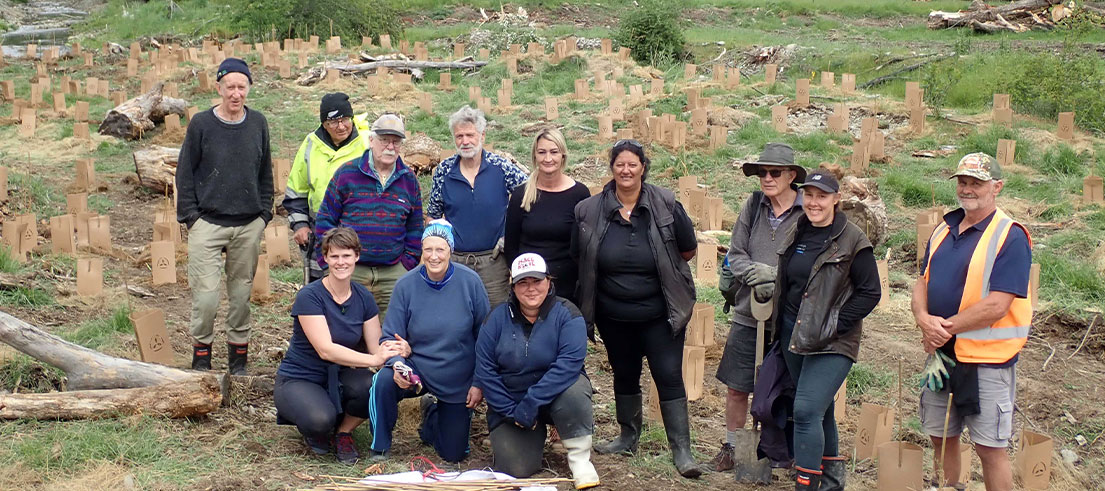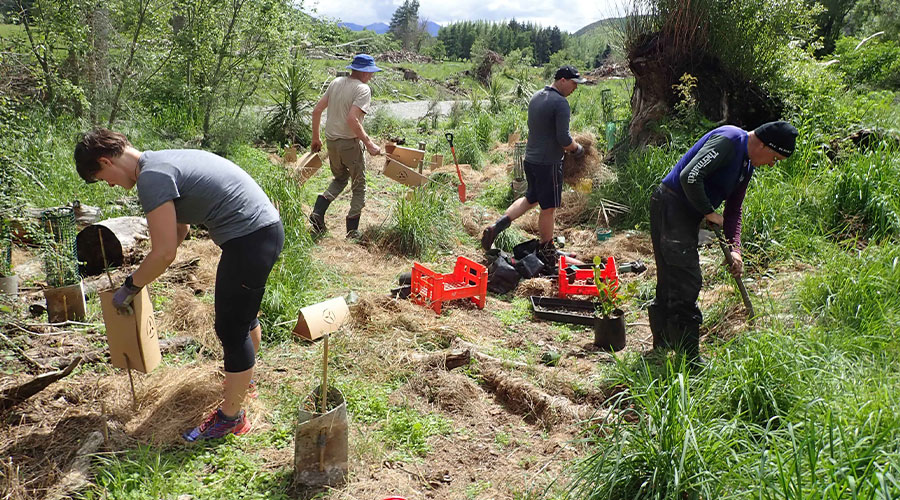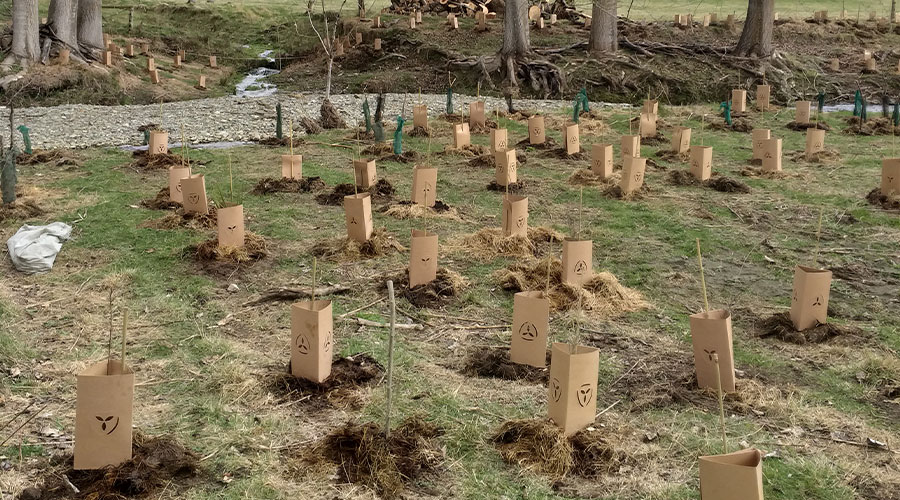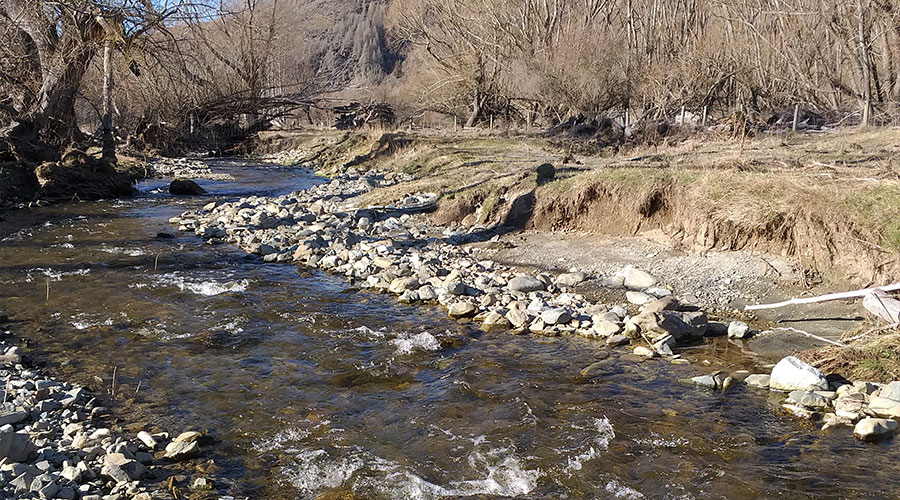
Restoration mahi underway at Te Kopi-O-Te Ōpihi/Burkes Pass
A weedy stretch of the Ōpihi River will be transformed at Te Kopi-O-Te Ōpihi/Burkes Pass, allowing people to enjoy nature and learn about the history of the area as an important place for gathering kai and resources.
The long-term project is underway with support from the Ōrāri Temuka Ōpihi Pareora (OTOP) Water Zone Committee, who have supported with more than $13,800 as part of its action plan funding. The project includes willow control, fencing, native riparian planting, extending a public walking track and sharing mana whenua’s story through interpretive panels.
Local resident and forming member of the Burke’s Pass Heritage Trust, Jane Batchelor has been passionate about the restoration in Burkes Pass area since she purchased a historic cob cottage more than 30 years ago.
"Along with my husband Graham, we created a nursery using locally-sourced seeds and have restored an area of native bush on our property, as well as parts of a public walking track alongside the heritage trust.
"That work has now come to fruition, it’s amazing to now see the bush maturing with a canopy that has started to regenerate itself, and together with predator control we have seen a huge increase of native bird life in the area."
Current project
Jane said a public meeting two years ago spurred a collaborative effort between Arowhenua Native Nursery (Te Kete Tipuranga o Huirapa Ltd), and the community-based heritage trust to better understand and access Māori history.
"The current project could only evolve and come together with a collaborative effort and funding from the OTOP Water Zone Committee.
"Funding is essential for the important work of removing invasive and hazardous willows and to re-vegetate with eco-sourced natives to improve the water quality and enhance the biodiversity of the river. Planting and maintenance will be done with our enthusiastic community volunteers."
"A public walking track through the restoration area will form a 1 km extension of the existing Burkes Pass Heritage Walk. We are delighted that this project now seems achievable."
Mana whenua connection
Lex Evans from Arowhenua Native Nursery said that projects like this are important for the community and the environment, to install the mauri back into the awa/river.
This mahi is at the Ōpihi River's headwaters, a culturally significant area for its mahinga kai, and also as a pathway to Te Manahuna (the Mackenzie Basin).
"This project is a great opportunity to educate the community through interpretation panels highlighting the story of mana whenua and the history of the area."
The nursery eco-sources native seeds from throughout the area, which are used to grow native plants. The nursery takes pride in producing plants that will enhance the awa/river by helping to create ecological corridors.
"We're passionate about growing plants, growing people, and enhancing the environment."
Alignment with action plan goals
Former zone committee Chair Lucy Millar says the Te Kopi-O-Te Ōpihi project aligns well with the committee’s action plan goals.
"Two priorities that the zone committee have committed to through their action plan are to protect, enhance, and restore mahinga kai sites and raise awareness of how to engage in a more positive manner with rūnanga.
"It is also a good example of engaging with mana whenua to enhance an area through weed control, planting, and hosting planting wānanga at the site with the landowner’s support."
Funding for local projects
Each of Canterbury’s water zone committees has an action plan which outlines how they will work with the community to deliver their aspirations for freshwater, as outlined in the Canterbury Water Management Strategy (CWMS). Committees, including OTOP Water Zone Committee, were provided $50,000, to support projects in their zones.
Ōrāri Temuka Ōpihi Pareora (OTOP) has supported the following projects as part of its action plan this year:
- Te Kopi-O-Te Ōpihi restoration: $13,844
- Catchment Collective South Canterbury Support: $10,000
- Geraldine Men’s Shed trap project: $7,656
- Te Ahi Tarakihi catchment restoration project: $4,000
- Drinking water road show events: $3,329
- Field trip to and support of Ōpihi taniwha site: $3,000
- Te Tiriti Course: $6,600
Catchment Collective South Canterbury Support
The Catchment Collective South Canterbury received funding to host the following events, with the support of the OTOP Zone Committee:
- Training and advice on Farm Environment Plan via workshops, particularly with a catchment-wide context. The Catchment Collective will be collaborating with Beef and Lamb New Zealand, enabling farmers and their catchment communities to understand catchment-specific risks, appropriate mitigations, and catchment priorities.
- Training for local catchment group members and landowners to raise awareness on how to better engage with local rūnanga (either through Te Tiriti o Waitangi training or similar).
Geraldine Men’s Shed trap project
This project is a partnership with the Department of Conservation (DOC), the Geraldine Trapping Alliance and Men's Shed Geraldine, where the Men’s Shed will construct and assemble trap boxes to DOC approved specifications. The assembled traps will then be used by the Geraldine Trapping Alliance, DOC and any other community-based predator trapping projects in the area.
This project will provide a cost-effective supply of traps to the community. It supports Aotearoa’s Predator Free 2050 strategy and the enhancement and protection of breeding populations of indigenous birds and native long-tail bats. It also means that individuals who are not able-bodied enough to directly take part intrapping work, can contribute to environmental work through trap construction, assembly, and maintenance.
Te Ahi Tarakihi catchment restoration project
This project forms part of a wider programme of work within the Te Ahi Tarakihi Catchment, which includes residential Timaru and is a mataitai reserve. The programme is a collaboration of work by Environment Canterbury and Timaru District.
The funding will go towards enhancing the health and amenity values of the wetland area at the lower end of Te Ahi Tarakihi creek. The site is adjacent to a small lake which is classified as a Timaru District Significant Natural Area and offers habitat for indigenous bird species such as kotuku ngutupapa/royal spoonbill and kāruhiruhi/pied shag.
Initial funding is covering fencing to exclude stock from the creek and wetland, as well as rubble removal from the creek and surrounding area.
Drinking water road show events
Two community drop-in sessions were organised and delivered in May by the water zone committee. Members of public were offered on-site indicative well drinking water testing for nitrates and could spend time talking to committee members and scientists about water quality issues and how to undertake tests for bacteria like E. coli.
The sessions were supported by Waterwatch and NZ Federation of Freshwater Anglers, who undertook the tests, as well as Aqualinc and Environment Canterbury who offered expert advice.
Field trip to and support of Ōpihi taniwha site
The water zone committee organised and attended a session at the Opihi Taniwha Gully rock art site in May. Twenty-seven people attended in total including Catchment Collective South Canterbury members, members of the public and Te Rūnanga o Arowhenua.
The field trip aimed to improve the community's understanding of how to protect the rock art particularly related to farming, the history and significance of the art and surrounding area, and discussed the planting and restoration of the surrounding biodiversity/mahinga kai.
The funding covered a guided tour to the Ōpihi taniwha site and food for participants. Funding was also given for plants and plant maintenance at the site to continue ongoing restoration.
Te Tiriti Course
The zone committee organised and hosted a two-day Te Tiriti Course in June for members of southern zone committees, local catchment group members and the OTOP community. The aim was to improve local knowledge of New Zealand history and to raise awareness on how to better engage with local rūnanga.
Funding covered the course facilitator and material, Arowhenua Marae hire, pōwhiri and catering for two days.



